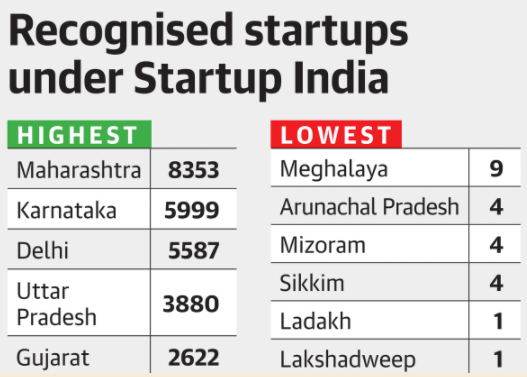The Start-up India initiative: A Quick review


This topic of “The Start-up India initiative: A Quick review” is important from the perspective of the UPSC IAS Examination, which falls under General Studies Portion.
Context
A paper published in the Economic and Political Weekly
- The research paper reviews India’s entrepreneurial policy Start-up India, affirmed its positive impact in reducing regional entrepreneurial disparities.
What the editorial is about?
- A review of the Start-up India initiative and its current status.
- Entrepreneurial disparities (as an after effect of the Start-up initiative) and its major causes.
What is the Start-up India initiative?
First announced
- It was first announced by Indian PM during his address to the nation on Independence Day in 2015.
Role of DPI&T
- It was organized by the Department for the promotion of industry and internal trade (DPI&IT).
The Action plans
- The action plan for this initiative is focusing on three areas.
- Simplification and Handholding.
- Funding Support and Incentives.
- Industry-Academia Partnership and Incubation.
An additional area
- An additional area relating to this initiative is to discard restrictive States Government policies within this domain, such as
- License Raj
- Land Permissions
- Foreign Investment Proposals
- Environmental Clearances
Current status of the initiative
What do estimates have to say?
Number of registrations
- According to the Minister for Commerce and Industry, the entrepreneurial portal had more than 65,000 start-ups registered.
Unicorn status
- Of which, 40 attained the ‘unicorn’ status in the last twelve months, bringing the total as of date to 90.
Global ranking
- India now ranks third among global start-up ecosystems.
Regional entrepreneurial disparities
- The networking, training and mentoring facilities provided by Start-up India alongside entrepreneurship outreach campaigns in tier-2 and tier-3 cities, helped address regional entrepreneurial disparities in India.
What hampers the success of the initiative?
Concentration
- Entrepreneurship continues to be “highly concentrated” in three megacities, namely, Mumbai, Bengaluru and Delhi NCR.
- India’s venture capital industry is also clustered in and around these three cities.
- Such concentration can lead to increased economic inequality and hinder the emergence of entrepreneurs from industries other than those belonging to the clusters.
Representation
- The under-representation could be due to multiple factors such as caste-based economic exclusion, the urban and rural divide, lack of access to quality education and limited social networks.
No Special mention
- The Start-up India Action Plan document has no mention of the words such as ‘caste’, ‘tribe’, ‘marginalised’, ‘indigenous’ or ‘social group’.
Digital divide
- Additionally, the policy’s reliance on technology does not take into consideration India’s digital divide, especially with respect to urban and rural areas.
This contradicts the initiative’s very notion of making entrepreneurship in India inclusive.
Per cent of women participants
Government efforts
Reservation of fund
- 10% of the fund in the Fund of Funds operated by Small Industries Development Bank of India (SIDBI) has been reserved for women-led start-ups.
- Further, all the alternate investment funds where the SIDBI takes equity have been mandated to contribute 20% to businesses that are women-led.
Other efforts
- There is a capacity-building program and a dedicated webpage for women on the portal.
Still, there is an under-representation of women and marginalized caste groups in the national start-up ecosystem.
Need of the hour
Encouragement and Support
- There is a need for policies and progressive strategies from governments to encourage start-ups and provide access and assistance in key areas including tax clarity, incubation, affordability and licensing.
Entrepreneurial ecosystem
- In any case, governments should be well prepared and dedicated to creating a culture of start-ups to impact the entrepreneurial ecosystem in their cities, countries and citizens.
Practice Question for Mains
- Start-up India was introduced in 2016 as a “clarion call to innovators, entrepreneurs, and thinkers of the nation to lead from the front in driving India’s sustainable growth and create large scale employment opportunities.” How far do you agree that it has achieved its moto after the completion of five years from its launch? (250 Words, 15 Marks)
Referred Sources


